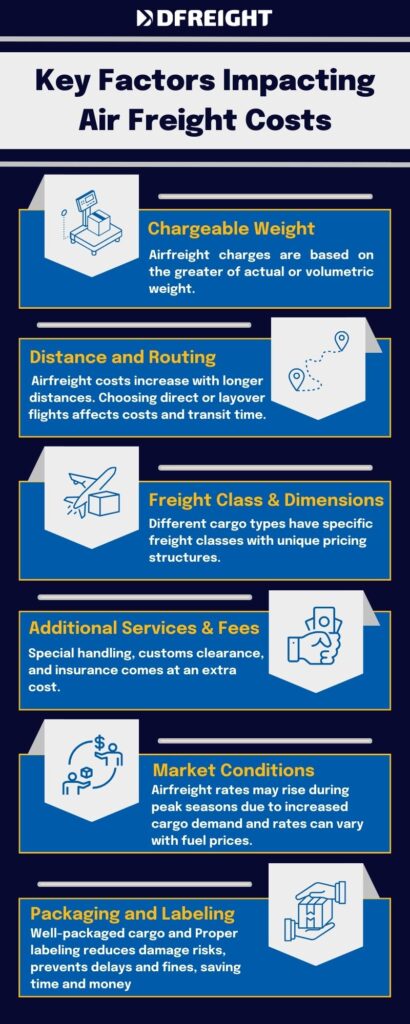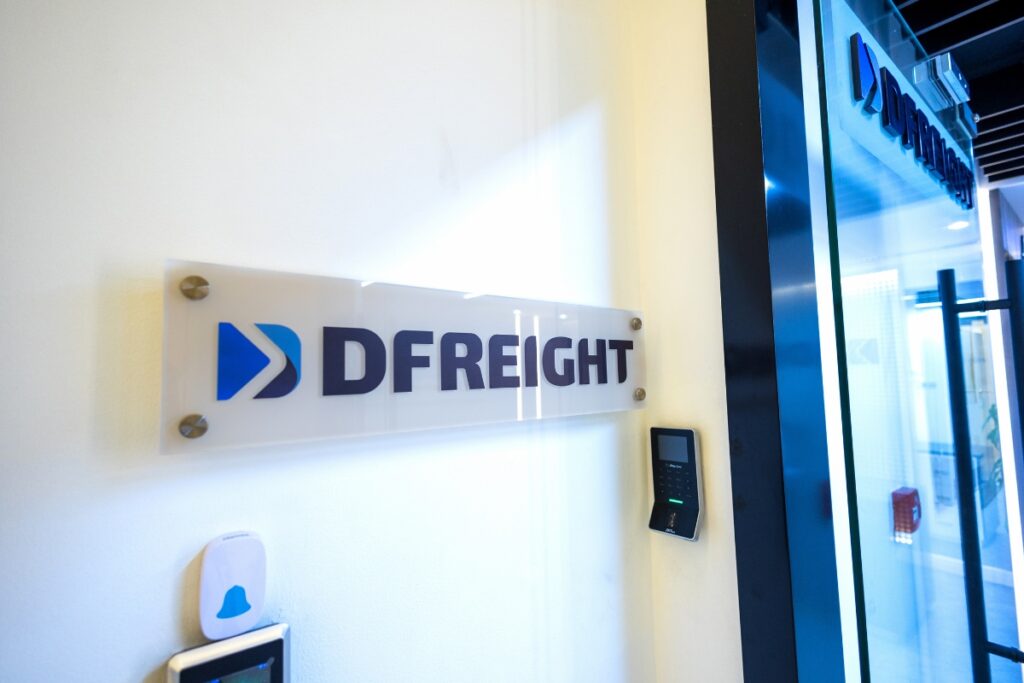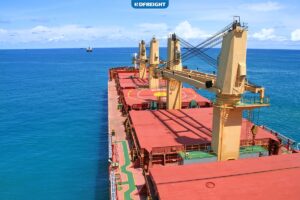In today’s globalized world, the swift and efficient movement of goods across borders is pivotal for businesses of all sizes. Air freight stands out as a speedy and reliable option among the various methods of cargo transportation. However, the convenience and speed of air transportation come at a cost, and understanding and accurately calculating air freight costs are essential for effective supply chain management and budgeting.
Ready to optimize your air freight logistics and experience unmatched service? Look no further than DFreight! Our commitment to accurate timing, transparent pricing, and guaranteed space sets us apart as the go-to choice for air freights, especially from the Netherlands and Germany to the UAE. Leap with DFreight today and ensure your cargo arrives on time, on budget, and with peace of mind. Let’s streamline your supply chain and elevate your shipping experience together!
“A Deep Dive into Calculating Air Freight Cost” is your comprehensive guide to unraveling the intricacies of air freight pricing. Whether you’re a logistics professional, a business owner, or simply curious about how air freight costs are determined, this blog post will equip you with the knowledge and tools to make informed decisions and optimize your shipping operations.
Table of Contents
Factors Affecting Air Freight Costs
When calculating air freight costs, there is no one-size-fits-all formula. Many factors influence the final price of shipping goods by air, each significant in determining the overall expense. Here, we break down the key factors that can impact your air freight costs:

Weight and Volume Considerations:
- Chargeable Weight: Airfreight charges are often calculated based on the greater of the actual or volumetric weight of the shipment. Volumetric weight considers the cargo’s size and dimensions, ensuring that lightweight but bulky items are appropriately priced.
Distance and Routing:
- Distance Traveled: The farther your goods need to travel, the higher the cost. Airfreight costs are directly proportional to the distance between the origin and destination.
- Routing and Stopovers: Choosing airlines and routing can significantly affect costs. Direct flights are generally more expensive than flights with layovers, but they can also reduce transit time.
Freight Class and Dimensions:
- Cargo Type: Different types of cargo fall into specific freight classes, each with its pricing structure. Hazardous materials, perishables, and oversized items often incur additional charges.
- Dimensions: The size and shape of your cargo impact the space it occupies on the aircraft. Irregularly shaped or oversized items may require special handling and incur extra fees.
Additional Services and Fees:
- Special Handling: Fragile or sensitive items, such as temperature-controlled storage or delicate cargo containers, may require special handling.
- Customs Clearance: Import and export duties, taxes, and customs clearance fees can significantly cost international air shipments.
- Insurance: Optional cargo insurance can protect against loss or damage during transit but comes at an additional cost.
Seasonal Demand and Market Conditions:
- Peak Seasons: During peak holiday or seasonal periods, airfreight rates may rise due to increased demand for cargo space.
- Market Fluctuations: Airfreight rates can fluctuate based on market conditions, such as fuel prices and economic factors.
Packaging and Labeling:
- Packaging Quality: Well-packaged cargo reduces the risk of damage and loss, potentially lowering insurance costs.
- Labeling Accuracy: Accurate and compliant labeling helps prevent delays and potential fines, saving time and money.
Understanding these factors and their interplay is crucial for effectively managing air freight costs. It’s essential to consider these variables, plan shipments carefully, and work closely with logistics experts who can navigate the complexities of air freight pricing to ensure cost-effective and timely deliveries to optimize your air cargo expenses.
Air Freight Cost Components
Air freight cost components encompass the various elements that contribute to the final price of shipping goods by air. These components are integral to understanding and budgeting for air cargo expenses. They typically include the base freight charges, which form the foundation of the cost, fuel surcharges that fluctuate with oil prices, handling and security fees associated with cargo processing and safety measures, and customs and documentation costs essential for international shipments. Comprehending these cost components is vital for businesses seeking to manage their air freight expenses effectively and make informed decisions about their shipping strategies.
Tools and Resources for Calculating Air Freight Costs
Navigating the intricate world of air freight cost calculation is made considerably more manageable with specialized tools and resources. Here’s a brief overview of some valuable assets at your disposal:
- Online Freight Rate Calculators: Numerous online platforms and websites offer user-friendly freight rate calculators. These tools typically require inputting details such as shipment weight, dimensions, origin, and destination. They can provide instant estimates, helping you compare rates from different carriers and make cost-effective decisions.
- Airline and Freight Forwarder Websites: Airline websites often provide detailed information about freight services, including rate charts and calculators. Freight forwarder websites offer a wealth of resources, including rate quotes, shipment tracking, and valuable insights into the logistics process.
- Excel Templates and Spreadsheets: Excel templates and spreadsheets can be a powerful resource for those who prefer more in-depth analysis and customization. These templates allow you to create detailed cost breakdowns, track expenses, and perform scenario analyses based on your shipping needs.
- Freight Management Software: Advanced logistics software solutions, including transportation management systems (TMS), can streamline calculating air freight costs. These tools can integrate with various carriers, automate rate comparisons, and provide real-time visibility into shipments and expenses.
- Industry Publications and Guides: Access to industry-specific publications, guides, and whitepapers can offer valuable insights into air freight cost factors, market trends, and best practices. These resources are beneficial for staying informed about the latest developments in the logistics field.
- Consulting Services: If you’re dealing with complex logistics or international shipments, consulting with logistics experts or freight auditors can be invaluable. They can offer personalized guidance, negotiate rates on your behalf, and help you optimize your supply chain for cost savings.
- Trade Associations and Networking: Joining trade associations related to your industry or logistics can provide access to a network of professionals who can share insights, recommendations, and best practices for managing air freight costs effectively.
These tools and resources empower businesses to make informed decisions, optimize shipping strategies, and reduce air freight expenses. By leveraging the right combination of these assets, you can gain a competitive edge in the dynamic world of air cargo logistics.
Straight to Your Destination: DFreight’s Air Freight Excellence
DFreight, the digital freight forwarder, excels in providing the best air freight costs, particularly for shipments from the Netherlands and Germany to the UAE. What sets DFreight apart is its unwavering commitment to delivering top-notch service. With accurate timing, clients can rely on punctual deliveries, ensuring their supply chains remain efficient. DFreight’s transparency shines through in its transparent and competitive pricing, allowing businesses to budget confidently. Moreover, the guarantee of space ensures that your cargo will always find its place on the plane, even during peak seasons. DFreight’s dedication to quality, reliability, and cost-effectiveness makes it a trusted partner for air freight logistics between these regions and worldwide.

Tips for Reducing Air Freight Costs
Managing air freight costs effectively is a priority for businesses seeking to maintain a competitive edge in the global marketplace. Here are some valuable tips to help you reduce your air freight expenses without compromising on the quality and reliability of your shipments:
- Consolidation and Optimization: Combine smaller shipments into larger, more cost-effective loads whenever possible. This reduces the per-unit shipping cost and minimizes empty cargo space on aircraft.
- Packaging and Labeling Strategies: Invest in efficient packaging that maximizes space utilization and protects goods from damage. Proper labeling and accurate documentation prevent delays and costly errors during customs clearance.
- Carrier Selection and Relationships: Build strong relationships with airlines and freight forwarders. Long-term partnerships can lead to preferential rates and better service. Compare quotes from multiple carriers to ensure you’re getting the best deal.
- Advance Planning: Plan shipments well in advance to avoid expedited or last-minute bookings, which are more expensive. Predictable schedules allow for better rate negotiations.
- Route Optimization: Opt for the most direct and efficient routes to minimize transit time and fuel costs. Evaluate the trade-offs between speed and cost carefully.
- Cargo Insurance: While it adds an expense, cargo insurance can be a wise investment to protect against unforeseen loss or damage. It can reduce financial risks associated with damaged or lost goods.
- Inventory Management: Maintain optimal inventory levels to avoid rush orders and costly air shipments. Implement just-in-time (JIT) inventory practices to minimize the need for expedited shipping.
- Leverage Technology: Utilize transportation management systems (TMS) and logistics software to streamline operations, track shipments, and identify cost-saving opportunities.
- Negotiate Contract Rates: If your business regularly ships via air freight, negotiate contract rates with carriers. Long-term agreements can provide stability and cost advantages.
- Environmental Considerations: Explore eco-friendly practices and technologies, such as carbon offset programs, to align with sustainability goals while potentially reducing costs.
- Stay Informed: Monitor market trends, fuel prices, and industry developments. Being aware of changes in the air freight landscape allows you to adapt and make informed decisions.
- Audit Freight Invoices: Regularly audit your air freight invoices to ensure accuracy and compliance with negotiated rates. Identify and rectify any billing discrepancies promptly.
- Utilize Freight Forwarders: Freight forwarders often have the expertise and industry connections to secure competitive rates and manage the logistics process efficiently on your behalf.
By implementing these tips, businesses can balance cost efficiency and timely delivery, ultimately optimizing their air freight operations. Effective cost management in air cargo transportation can lead to increased competitiveness and improved profitability in the global market.
Conclusion
In conclusion, understanding and effectively managing air freight costs are essential for businesses seeking to thrive in the global marketplace. We’ve explored the intricate factors that influence these costs, the components of the pricing structure, and valuable tools for accurate calculation. By implementing the tips for cost reduction, businesses can balance cost efficiency and reliable cargo transportation. In this digital age, companies like DFreight empower businesses to make real-time cost-conscious decisions. As the world of logistics continues to evolve, staying informed, adaptable, and innovative will be key to achieving success in air freight management.
What factors influence air freight costs?
Air freight costs are influenced by factors such as weight and volume, distance, cargo type, routing, handling fees, and fuel surcharges, among others.
How is air freight cost calculated?
Air freight costs are typically calculated based on chargeable weight (actual or volumetric weight) and may include various surcharges and fees, depending on the carrier and service.
What is volumetric weight, and how is it calculated?
Volumetric weight is a way to account for the space cargo occupies in the aircraft. It’s calculated by multiplying the length, width, and height of the shipment in centimeters and dividing by a volumetric factor.
Are there ways to reduce air freight costs?
Yes, cost-saving strategies include consolidation, optimizing packaging, careful route selection, building strong carrier relationships, and planning shipments in advance, among others.
What are some additional fees that may be incurred in air freight?
Additional fees can include customs clearance charges, security fees, handling fees, and optional services like insurance or expedited handling.
How can a digital freight forwarder help with air freight cost optimization?
Digital freight forwarders like DFreight often provide real-time pricing, transparency, and efficiency, enabling businesses to make cost-effective decisions on-the-fly.














